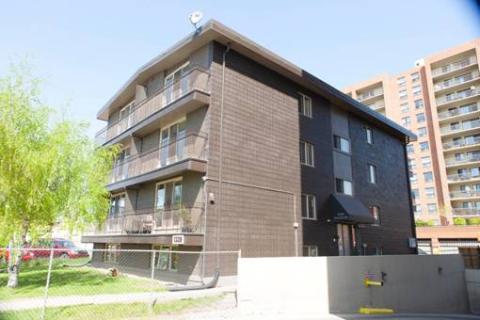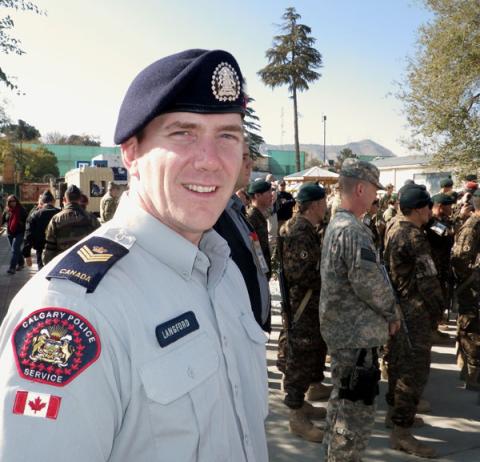
For the first time in nearly 10 years, the former Canadian Armed Forces vet has a home, occupying one of the 15 apartments that comprise The Madison Building, Calgary’s first affordable housing complex dedicated to helping homeless ex-military personnel find a place to call their own.
“It’s still overwhelming,” says Snyder, 43, who served with the Canadian Armed Forces in Cyprus and Norway for three-and-a-half years.
Located in Calgary’s Beltline District, and sponsored in part by the Calgary Homeless Foundation and the Alberta Provincial government, The Madison Building was recently awarded $540,000 by the Canadian Federal Government to continue providing help for veterans who have fallen on hard times.
In an effort to eradicate Canadian veteran homelessness, the federal funding is part of a $1.9 million two-year pilot project extended to organizations that currently run homeless programs in Calgary, Victoria, Toronto and London, ON. An additional $1.8 million worth of contributions from Veteran Affairs Canada are also earmarked for the endeavour.
Initially spearheaded by Calgary Police Sgt. John Langford and former Calgary Homeless Foundation president Tim Richter (recently appointed new president of the Canadian Alliance to End Homelessness, or CAEH), the two pooled their resources and lobbied the Federal government to pitch in.
A former military man himself, Langford was working downtown with the Calgary Police Service when he discovered there were some Canadian Forces vets living on the streets.
“That really bothered me, being ex-military,” recalls Langford, who is currently finishing duty in Kabul, Afghanistan as a member of the International Peace Operations branch, mentoring and advising the Afghan National Police.
“So I started looking for options for these guys.”
Langford didn’t really know where to start, and after a little research, contacted Veterans Affairs and the Canadian Legion “to see if they were eligible to receive any benefits or pensions that they weren’t aware they were even eligible for.”
He soon teamed up with the Calgary Homeless Foundation and realized that some of them needed immediate care and counseling.
“That was the first step: just getting social workers in place that would understand the military background of all these guys and just make things a little more specific to them,” Langford explains.
Langford eventually forged a relationship with Veteran Affairs to the point “where I could just walk in off the street in full uniform with these guys and set them up with a case worker.”
Langford said he was alarmed at the number of homeless veterans that are in Calgary alone.

In 2011, Langford contacted Tim Richter.
“He approached me a year-and-a-half ago with an idea for a veteran’s house, and I happened to be in a position where we had some capital available from the province,” says Richter. “So pretty quickly, we put together the project that was eventually funded by the federal government.”
Tenants at the Madison Building “pay about 30 percent of their income to stay in affordable housing, but they all get a subsidy and pay cheaper rent,” Richter explains.
Even though they’ve identified approximately 30 indigent veterans, Richter says more may be out there.
“It’s tough to say partly because veterans tend to be the last people who come forth,” Richter observes. “They’re pretty proud and stubborn and they don’t want to be a burden.
“I do believe there’s a larger issue out there of veterans living in poverty and insufficient housing. We have a Veteran’s Food Bank in Calgary, for example. So there are a variety of challenges.”
Richter expects the numbers of disenfranchised vets to rise.
“I think we’re fortunate in Canada, on the one hand, that for the most part, our support programs are pretty good. But I don’t think we’ve really seen the full impact of the long war in Afghanistan.
“In America and in the U.K. there are significantly worse problems, but that comes part and parcel with the size of their militaries and the number of conflicts that they’ve been involved in.
“We’re a byproduct of that, so there aren’t as many homeless veterans here as you see in the States. It’s not on that kind of scale.”
Although the numbers may be small, Richter views the July announcement of the program by Veteran Affairs Minister Steven Blaney and Human Resources Minister Diane Finley as extremely significant.
“It acknowledges the duties that the Government of Canada and our communities have to our veterans. They’ve put themselves in harm’s way for us and we have duties of care for them, so I think that’s important.
“The major significance of this to me is the Federal government stepping in to ensure that no Canadian veterans go homeless.”
The reasons armed forces vets end up on the streets can vary, says John Langford, noting that the transition from military life to civilian can be quite jarring.
“Somebody could come back from a mission overseas – they could even do a couple of more years in the military and then get out – and not have anything surface, until they get out, and it starts to fester.
“That’s when problems arise,” he says, noting that post-traumatic stress disorder, alcoholism and addiction are some of the maladies that can plague ex-military vets.
“I’m not saying everybody has it, but the symptoms of being in those environments often takes quite a while to surface,” Langford explains.
For his part, Madison Building resident Cameron Snyder says he drifted between alcoholism and addiction for years, intermittently staying in numerous shelters and somewhat unemployable.
“It’s hard to concentrate on your capabilities when you’re on the streets,” Snyder admits. “But this give me a fresh start. It wasn’t looking good there for a while.”
Is a $1.9 million investment enough?
“It’s certainly enough to prove how to house and show how to house veterans successfully, but the people that we’re housing need long-term support,” Richter replies. “These aren’t the guys who are going to be independent on their own in two years.”
John Langford adds:
“If there’s even one homeless vet on the street, we have to do something about it. With the program in place in those cities, it will certainly be beneficial.”
All Cameron Snyder knows is that he’s been given a roof overhead and a fixed address that will allow him to try and find a steady job – and he’s grateful.
“It’s changed my life and given me hope.”
adidas Yeezy Boost 350